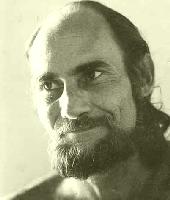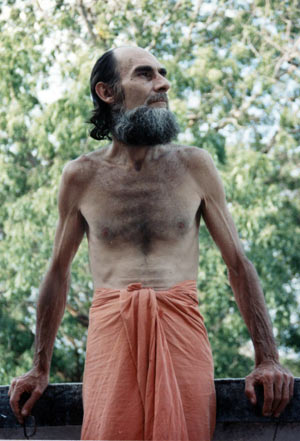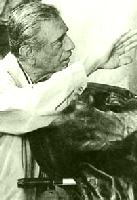|
| |||||||

"The Enigmatic Mr. Wilson" Part IIIThe Tenth Avatar of Vishnu
In this three-part article, Richard Boyle documents the life of Mike Wilson (Swami Siva Kalki) 1934-1995,who among other things made a significant contribution to the Sinhala film industry, and pioneered underwater exploration around the island. Being the second anniversary of the death of Mike Wilson (Swami Siva Kalki), as well as the golden jubilee of the Sinhala film industry, the time seems right to look back on the life of this remarkable man. While the name Mike Wilson is familiar mainly to a certain generation of cinema-goers in Sri Lanka as the director of films such as Ran Muthu Duwa, others know of him as the diver who recovered the lingam associated with the Tiru Koneswaram temple and silver treasure from a wreck on the Great Basses. Some know of him as the Swami who championed Kataragama; some as the man who was claimed to be responsible for wrecking Satyajit Ray's science fiction film project, The Alien. The very late sixties and early seventies were extremely turbulent years for Mike Wilson both professionally and personally. During this period he tried to develop several film projects - the most promising being an adaptation of Hasan, Piers Jacob's spiritual novel with a Sri Lankan setting - but nothing materialised. His friendship with Arthur C. Clarke had reached a crisis point. However, his decision to quit the household life at the age of 40 was no hasty act of renunciation but a premeditated metamorphosis that began twenty years previously with his highly significant and symbolic discovery of the legendary Swayambhuva Lingam of the Konesar Temple. "It changed me completely", he declared in an interview in The Sunday Times of 18 November, 1990. "It was diksha (initiation) and darshan (divine vision) all in one. I understood something, how I had spent many lives here in Sri Lanka already, how this was not my first. I was prompted to go to Kataragama. One needs a place to sit and ponder; that place for me was Kataragama." For his new life Wilson had taken the name Swami Siva Kalki. Apart from Siva's connection with Kataragama, it is of significance that his most important emblem is the lingam. Of course, various contradictory and complementary aspects are welded together in the concept of Siva: He is both creative and destructive, austere and exuberant self-controlled and orgiastic, benevolent and fierce. Perhaps it is not mere coincidence that the man who took his spiritual name from Siva embodied all these characteristics and contradictions. Believed to be the tenth avatar of Vishnu, Kalki will come in glory to establish a golden age by judging humankind, destroying the world and creating a new and superior race. Kalki will appear mounted on a white horse. Then he is supposed to draw his sword, which will 'blaze like a comet', and the wicked will be annihilated, the age of the Kaliyuga ended. This apocalyptic theme was pursued by Gore Vidal in his novel Kalki (1978). It relates the story of James Kelly, a Vietnam veteran who settles in Asia after the war and then returns to the United States to implement his plan for the destruction of the entire human race - that is apart from himself and his female followers. Although Vidal is a friend of Clarke and has even visited Sri Lanka, there is nothing to suggest that this fictional Kalki was modeled on Wilson. Swami Siva Kalki spent a portion of the years 1975 to 1985 at Kataragama, living in a Kuti, in the garden of the local postmaster's residence. Eventually, however, the rigours of this ascetic life, combined with recurrent and increasingly debilitating bouts of malaria, forced him to return to Colombo on a more-or-less permanent basis, apart from the occasional foray into the spiritual hinterland. So it was that he lived out the last ten years of his life mostly in the city or its suburbs, staying with a succession of friends and family members. He spent two decades leading the life of a Swami - not always successfully, but with an intensity and conviction that made up for any deficiencies on his part. As a Westerner he occupied an unique position and commanded an unusual perspective. William Mc Gowan in his book on Sri Lanka's ethnic crisis, Only Man is Vile : The Tragedy of Sri Lanka states that Swami Siva Kalki 'lived at the odd intersection of the expatriate academic community, the local intelligentsia, and the community of Lankan spiritual seekers'. It was an odd intersection indeed, and his location there induced him to champion some remarkable causes. For instance in the early 1980s, when the Swamis of Kataragama were being harassed, he composed a lengthy 'curse' to place on the relevant authorities for interfering with the Swamis' traditional practices. This came to be published in the international magazine, High Times. Despite humble origins and only a basic education, Wilson became something of a polymath in his adult life. His learning extended in many directions, embracing on the one hand an exhaustive knowledge of human spirituality, comparative religion and universal tradition, while on the other, an impressive understanding of the sciences. Indeed during the last twenty years of his life the formulation of a Unified Field Theory became his magnificent obsession. In the abstract to his unpublished paper A New Approach to Field Unification he explains: 'This model seeks to demonstrate that the four fundamental forces of nature and their fields can be successfully unified by the correct application of Maxwell's four electromagnetic equations. It seeks to demonstrate how Maxwell's equations can be validly extended to describe the functions in other fields. seeks to demonstrate how these four equations are in fact laws which may be seen working in all physical situations; and how every physical situation can be completely described by means of these equations alone. It seeks to demonstrate that Maxwell wrote the four fundamental laws of Nature - the Unified Field Equations without realizing it.'
After he donned robes, Swami Siva Kalki did not let his spiritual preoccupations constrain either his intellectual pursuits or his abiding interest in the arts, especially film. Indeed throughout his years as a Swami, writing for the screen remained a bridge that linked him to his former life. In the mid-1970s, during the initial stage of our friendship, I collaborated with him in writing several, ultimately unproduceable, screenplays with spiritual themes, such as The Gospel Accordinq to St. Thomas (concerning the apostle's reputed sojourn in India) and A Story for the Older Child. The latter script, which was also co-written by Manik Sandrasagra, took Swami Siva Kalki to London exactly ten years after he last went there in connection with Satyajit Ray's The Alien. Temporarily swopping his robes for a pair of jeans and a polo neck sweater, he slipped back easily into his past existence. He was accompanied to London by Sandrasagra and myself, and together with the producer Dimitri Grunwald we endeavoured without success to put together a package, despite encouragement from John Boorman among others. A Story for the Older Child is of interest because, like The Alien, it turned upside down the Westernised plot conventions of most science-fiction films. The story is set at the end of the 21st Century, when Earth has settled down to an uneasy peace under a Technocratic Instrumentality. Athena, a giant computer, makes possible the fair distribution of food, shelter and entertainment to the billions of subscribers to the system. Other groups, such as the remnants of the once-great religions reject this scientific materialism, preferring to live traditional lives. One day an alien entity known as Anfal falls into Earth orbit. Anfal's mission is to scour the Universe for wisdom, and after hooking up with a television satellite, it requests a discussion with Sumedha, a Buddhist monk who is also a presenter at the Voice of Dharma, a Buddhist television station in Sri Lanka. There follow a number of televised philosophical discussions between Sumedha and Anfal that are viewed by most of the population of the planet. Politicians are thrown into disarray by this turn of events. As the old order crumbles, a new consciousness arises and Anfal becomes an Arahant. In addition, Swami Siva Kalki provided the religious dialogue for my script, Rampage. This story of a psychic elephant hell-bent on avenging the death of its mother was directed in 1977 by Manik Sandrasagra and starred Gamini Fonseka and Chris Greet.
Needless to say, Swami Siva Kalki was no stranger to controversy. In particular, a series of documentary scripts written by him on the spiritual festivals of Asia was to cause considerable alarm among religious groups, academics and television executives in Australia, of all places. During the annual Kataragama Festival of 1984, Swami Siva Kalki met the Australian film producer Albert Falzon, who was there to cover this spectacular event. Falzon's main claim to fame at that time was the cult surfing movie Crystal Voyager. For Falzon especially it was a fortuitous meeting, because he had not as yet found a scriptwriter with sufficient grasp of the complex and sometimes esoteric subject matter. Over the next eighteen months Swami Siva Kalki wrote six scripts for the series, Festivals of the Far East. The first film in the series, on the Kataragama Festival, received its world premiere when it was broadcast on ITN in Sri Lanka in July 1986. Ironically, although this film was broadcast without any adverse comment in Sri Lanka, when it was screened by the Australian Broadcasting Corporation the following year there was considerable consternation. Jonathan Holmes, Head of Television Documentaries at ABC wrote to Falzon: 'You may be interested to know that the Buddhist Council of New South Wales was outraged by it. So are most Hindus who have seen it. For an independent assessment Holmes had sent the Kataragama film to Dr. Eric Sharpe, Professor of Comparative Religion at the University of Sydney. Professor Sharpe's report on the film was particularly scathing. It described the narration as 'shuttling uneasily back and forth between Hindu and Buddhist ideas, and slipping over and over again into a worldly transcendentalism'. He concluded with authority that 'in confusing Hindu and Buddhist elements in the festival it offended Sri Lankans who consider the national religion of the country to be Buddhist'. Apart from his erroneous conviction that the film had offended Sri Lankan Buddhists, Professor Sharpe demonstrated his incomprehension regarding Kataragama (which he had never visited), as well as the blurred interface between Hinduism and Buddhism in a multi-religious country such as Sri Lanka. In addition, the protests and assessments confirmed the chasm that exists between Western converts to Buddhism, who have almost without exception made the intellectual transition for the sake of its teachings, and Eastern Buddhists, whose culture demands ritual. At the time Professor Sharpe compiled his report it is obvious that he had no idea as to the identity of the scriptwriter whose work he was criticising. Neither did he know the nature of this man; a man who had lived the Kataragama experience for many years and who was the master of the lengthy rejoinder. In September 1987, when Sharpe received a 57-page reply to his averments, complete with glossary, he may well have wished that he had never been requested to write the report. "I trust you will understand", wrote Swami Siva Kalki, "that when you call into question the validity of the expressed interpretations which accompanied the images of these films, you are calling into question a body of tradition with which you are obviously totally unfamiliar. You also call into question the validity of the traditional systems of academic training - as well as certain aspects of the western academic tradition - which exist both in Sri Lanka and India." Swami Siva Kalki continued by quoting expansively from a number of religious texts, and by using persuasive argument, to pour scorn on Sharpe's analysis. "The object of the film", he declared, "was not to show various prejudices (whether Buddhist, intellectual, or any other). Rather it was to show the lack of prejudice and wondrous synthesis that is the unique religion of Kataragama." For good measure, Swami Siva Kalki also wrote to Sharpe's colleague, the Chairman of the Buddhist Council of New South Wales, who supposedly had been 'outraged' by the film. According to Sharpe, the film 'contained no meditation and no philosophy', so therefore it could not be "Buddhist" as the Council understood it. 'Did anyone say it was a Buddhist film?' inquired the aggrieved Swami. Surely it is clear that Buddhism is only one component of Kataragama - although an important one. With regard to the question of philosophy, I can only remark that the Buddha has in many places spoken of the futility of all philosophies.' The scripts for the series Festivals of the Far East, together with the one for the documentary Nimrod's Tower (directed in 1989 by Sharmini Boyle) were the last to be written by Swami Siva Kalki. During the final years of his life he became preoccupied with writing his guide to meditation practice, The Dawn of the Arahants, an intriguing book that remains unpublished. The following extract will give an indication of its tenor: First we must thoroughly understand the cause of pollution, which we call defilement. There is no ecological pollution without mental defilement and no mental defilement free of mental pollution. Pollution is the effect of the cause - and the cause is mental defilement as first principle. To eradicate pollution we must eradicate defilement. This work must start within us. First, by identifying the defilements and seeing how they effect both ourselves and others as mental, physical and ecological pollution. Once the defilements are identified, steps have to be taken to get rid of them. That is the whole purpose of these exercises. Swami Siva Kalki died on 26 February, 1995 at the age of 61. This has been but a cursory glance at the life of a multi-faceted, delightfully, enigmatic man, who remained a paradox, to some. He was certainly no saint yet he was capable of displaying great compassion and wisdom. Soon after his death I wrote an appreciation of Swami Siva Kalki the opening sentence of which I believe still serves to encapsulate this remarkable man: In an age characterised by dross, conformity and inconsistency, Swami Siva Kalki (formerly known as Mike Wilson) was an honourable exception. Courtesy: The Sunday Times (Colombo) of 16th March 1997 Swami Siva Kalki and Ravana's Swayambhu Linga
|


 Satyajit
Ray: at odds with Wilson
Satyajit
Ray: at odds with Wilson